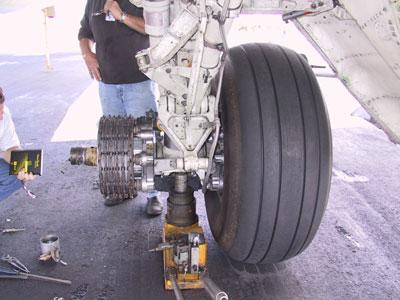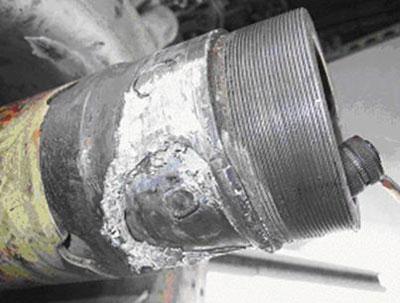While on approach to land at Perth, the crew of the Boeing 727 notified air traffic control (ATC) that they required runway 21 instead of 24. This was in consideration of the wet runway conditions and as a possible precaution should they experience antiskid problems. They also advised ATC to expect a normal approach.
After parking the aircraft, the crew reported the loss of the inner left main wheel and requested rescue fire-fighting services to attend while the aircraft was secured (see Figure 1.). An inspection of the Perth runway did not find any debris.
Figure 1. Left main landing gear missing number 2 wheel.
A search conducted at Melbourne airport, the point of departure, resulted in the recovery of debris from runway 34. The wheel had impacted the perimeter fence past the runway 34 overrun area and was recovered from that location.
Inspection of the landing gear revealed that the outer bearing had failed, which allowed the wheel assembly to migrate over the locked retaining nut and depart from the axle. Landing gear damage was confined to the sacrificial alloy axle sleeve (see Figure 2).
After completion of the Boeing Conditional Inspection following bearing failure, the alloy sleeve and main wheel were replaced. As a precaution, the operator also replaced the remaining three wheels of the main landing gears. As the nose landing gear wheels were from a different overhaul facility, it was not considered necessary to replace them prior to the aircraft returning to service. The line engineers who removed the main wheels verified that bearing dust seals were present on all the remaining wheel bearings.
Figure 2. Left main landing gear axle damage.
The inner bearing cone of the lost wheel was recovered from the aircraft landing gear and, along with the wheel bearings from the remaining three wheels, was sent to the ATSB for further technical analysis. The separated main wheel and bearing cone debris recovered in Melbourne were also forwarded to the ATSB.
Main wheel assemblies
The operator had recently acquired the aircraft on lease after it had been in long term storage in the USA. During the process of transfer to the Australian register, the American owner sourced a serviceable set of main wheel assemblies to standardise the aircraft with the rest of the Australian operator's fleet. The wheels carried release to service documentation after overhaul from an approved American maintenance facility.
The incident wheel (number 2) had been overhauled in accordance with approved data and released for service with the correct documentation on 14 November 2000. The wheel was subsequently fitted to the Boeing 727 on 31 August 2002. The wheel was in storage for all the intervening period between release to service and fitment to the aircraft. The remaining wheel (number 1) on the left landing gear had been overhauled in accordance with approved data and released for service with the proper documentation on 7 December 2001. The wheel was subsequently fitted to the aircraft on 31 August 2002.
Wheel numbers 3 and 4 on the right landing gear were overhauled in accordance with approved data and released for service with the proper documentation on 17 and 22 August 2001 respectively. The wheels were subsequently fitted to the aircraft on 29 August 2002. Although still a lengthy storage period, wheel numbers 1, 3 and 4 had been in storage for a significantly shorter period than wheel number 2.
The quality assurance inspector for the overhaul facility stated that, although not mandated, the company recommended to customers to re-inspect stored wheels every twelve months. He also stated that, after overhaul, all wheels were returned to their owners, and the company did not hold any wheels in long-term storage. As part of the shipment preparation, the overhaul company routinely packed the wheel bearings in grease and sealed them in plastic bags before they were placed in the wheel assemblies. The plastic bags were to be removed before the wheel re-entered service. With no wheel assemblies stored at the overhaul facility, the company had no requirement for a repetitive storage inspection procedure to be in place. This meant that the wheels fitted to the aircraft had been returned after overhaul to their owner (the aircraft owner) and were placed in storage at a site other than the overhaul facility. The aircraft owner had then supplied the wheels to the Australian operator for fitment to the Boeing 727.
At the time of the incident, the aircraft operator's maintenance control manual did not include a section relating to wheel storage and tracking procedures, which specifically mandated a storage life expiry interval and re-inspection procedure for wheels. The maintenance personnel who fitted the wheels to the aircraft stated that the wheels were received from the USA with the bearings in place. There were no reports of the bearings being received in plastic bags as described by the overhaul facility. There was also no paperwork supplied to the Australian operator to suggest that the wheels had been fitted to another aircraft after overhaul.
ATSB laboratory component examination
While damage to the failed bearing prevented the determination of specific factors that contributed to the failure of the particular unit, the evidence found during the investigation suggests that the development of corrosion damage over the contact surfaces of the wheel bearings was a major factor contributing to the failure. This was evident in the bearings examined from the remaining wheels. The corrosion led to insipient contact fatigue spalling, which is well understood can lead to catastrophic bearing failure consistent with the circumstances of this occurrence. The bearing lubricating grease was found to be congealed, hardened and in a dry state. A foreign material identified as brake dust was also found in the grease. The inclusion of this foreign material may also have contributed to the failure.




